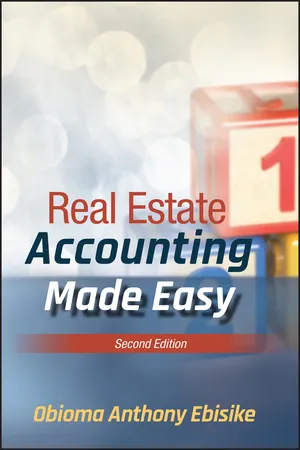
- English
- ePUB (mobile friendly)
- Available on iOS & Android
Real Estate Accounting Made Easy
About this book
Grasp the fundamentals of real estate accounting, finance, and investments
Real Estate Accounting Made Easy is just that—an accessible beginner's guide for anyone who needs to get up to speed on the field of real estate accounting, finance, and investments. Beginning with the elementary aspects of real estate to ensure that you're comfortable with the subject matter, it goes on to explore more in-depth topics in a way that's easy to digest.
The book begins with discussions on introduction to the real estate industry and basic real estate accounting. Building on knowledge from the initial chapters, the book goes on to cover the different form of real estate organizations, financial statements such as the balance sheet, income statement, shareholders equity and the statement cash flow, and more.
•Provides theories and practices of real estate from an accounting, financial, and investments perspective
•Advanced transactions are discussed in an easy-to-understand manner
•Content reflects the FASB's new standards on revenue recognition and lease accounting
•Accounting for operating property expenses, operating expenses reconciliation and recoveries, lease incentives and tenant improvements, budgeting, variance analysis are discussed in detail
•Covers types of financing for real estate acquisitions, accounting for real estate investments, project development costs, and real estate brokerage
•The book also walks you through the financial audit process
If real estate is a new territory for you, fear not! This book helps new auditors, accounting, finance, and investment professionals, and users of financial reports understand the fundamentals of the financial aspect of the real estate business.
Frequently asked questions
- Essential is ideal for learners and professionals who enjoy exploring a wide range of subjects. Access the Essential Library with 800,000+ trusted titles and best-sellers across business, personal growth, and the humanities. Includes unlimited reading time and Standard Read Aloud voice.
- Complete: Perfect for advanced learners and researchers needing full, unrestricted access. Unlock 1.4M+ books across hundreds of subjects, including academic and specialized titles. The Complete Plan also includes advanced features like Premium Read Aloud and Research Assistant.
Please note we cannot support devices running on iOS 13 and Android 7 or earlier. Learn more about using the app.
Information
1
INTRODUCTION TO REAL ESTATE
TYPES OF REAL ESTATE ASSETS
- Improved non-built land
- Residential properties
- Commercial office properties
- Industrial properties
- Retail properties
- Hotels
- Mixed use properties
Improved Non-built Land
Residential Properties
- Single-family and small multifamily properties
- Garden apartment buildings
- Mid-rise apartment buildings
- High-rise apartment buildings
Commercial Office Properties
Industrial Properties
Table of contents
- Cover
- Table of Contents
- About the Author
- Preface
- 1 INTRODUCTION TO REAL ESTATE
- 2 BASIC REAL ESTATE ACCOUNTING
- 3 FORMS OF REAL ESTATE ORGANIZATIONS
- 4 ACCOUNTING FOR OPERATING PROPERTY REVENUES
- 5 ACCOUNTING FOR OPERATING PROPERTY EXPENSES
- 6 OPERATING EXPENSE RECONCILIATION AND RECOVERIES
- 7 LEASE INCENTIVES AND TENANT IMPROVEMENTS
- 8 BUDGETING FOR OPERATING PROPERTIES
- 9 VARIANCE ANALYSIS
- 10 MARKET RESEARCH AND ANALYSIS
- 11 REAL ESTATE VALUATION AND INVESTMENT ANALYSIS
- 12 FINANCING OF REAL ESTATE
- 13 ACCOUNTING FOR REAL ESTATE INVESTMENTS AND ACQUISITION COSTS
- 14 ACCOUNTING FOR PROJECT DEVELOPMENT COSTS ON GAAP BASIS
- 15 REAL ESTATE DEVELOPMENT REVENUE RECOGNITIONS
- 16 REAL ESTATE BROKERAGE ACCOUNTING
- 17 AUDITS
- Index
- End User License Agreement